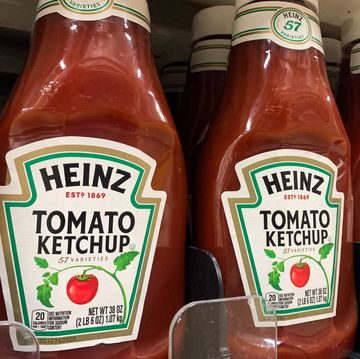If you’re like me, you use your blender for everything from mixing your morning smoothie to blitzing tomato sauce. And (also like me), you probably think you do a decent job cleaning it.
But did you know that, despite your best efforts, the inside of that blender is probably still one of the dirtiest places in your kitchen? A veritable home for all kinds of bacteria, including salmonella?
Here’s what you need to know about the germs that could be hiding in your blender, and how to clean it properly so you can trust your smoothies again.
More From Delish

The Enemy Lurking
A recent study from the National Sanitary Foundation (NFS) found that blenders were actually the “third germiest item” in the surveyed “test homes,” containing substantial amounts of bacteria. The primary hotspot? The blender gasket: that thin rubber ring that sits between the blender's blade and the container floor. That tiny piece of rubber is often home to a legion of bacteria, including “salmonella, E. coli, yeast and mold," according to the study.
And that’s not all. According to Rosemary Trout, program director of culinary arts and food science at Drexel University, there are tons of other, commonly overlooked places that deserve our attention. “Sometimes the blades don’t get cleaned well because people are concerned about avoiding cuts,” she says. “The cord can also be neglected.”
The cord? I have to admit I was skeptical. After all, the cord doesn’t typically even touch food, so why would we need to clean it?
Trout has an answer for that too: “Bacteria are everywhere. Cords, while not in direct contact with consumable food, can accumulate dirt and grime . . . [which] can act as nuclei or growth points for bacterial pathogens and mold.” So, just to be clear, any area of your blender, from the top of the lid to the underside of the base, can become a breeding ground for bacteria that could then transfer to whatever food you’re blending in that blender. Yikes!
And How To Defeat It
Lots of us swear by the trick of filling the blender container with a squirt of dish soap and a little warm water and then whizzing it up. This cleaning hack quickly distributes soapy water throughout the nooks and crannies of the blender container, effectively “cleaning” it. Taking it one step further, Guy Crosby, food science editor and adjunct associate professor at Harvard, recommends using a mixture of “one part vinegar with 2 parts water,” before thoroughly rinsing, which “avoids the problem of foaming.”
Both of these methods are effective in a pinch, but neither targets the external areas of the blender, and they definitely don’t promise to thoroughly clean that notorious bastion of bacteria, the gasket. Unfortunately there’s no quick and easy shortcut that targets these trouble spots: to ensure a thorough cleaning, you’ll need to take the blender apart. Fortunately, Trout has recommendations for that too.
“Disassemble your blender as much as possible and soak and wash these parts carefully in hot, soapy water,” she advises. To ensure complete sanitization, the “water temperature should be 171°F” and “the parts submerged for 30 seconds.” While you definitely shouldn't submerge the blender base (which contains the motor!) in water, she does recommend wiping all parts of it—including the unplugged cord—thoroughly with a washcloth soaked in “hot soapy water.”
Once every part of your blender has been scrubbed clean, there’s one last thing. “Be sure to completely air dry prior to reassembly and storage,” Trout says. If you put your blender back together before it’s totally dry, you’re creating the perfect dark, damp habitat for mold to thrive. After all your efforts toward a cleaner blender, you don’t want to pull it out the next day to discover it’s growing green fuzz.
Taylor Ann Spencer is the assistant food editor at Delish, where she develops recipes, creates recipe videos, and styles food. With a background in writing and theater as well as professional cooking, she enjoys sharing her love for global flavors and all things baking through informational posts, hosted videos, and just plain everyday conversations. When she's not cooking, she's brainstorming her next culinary mash-up. Mac 'n' cheese chili rellenos, anyone?












